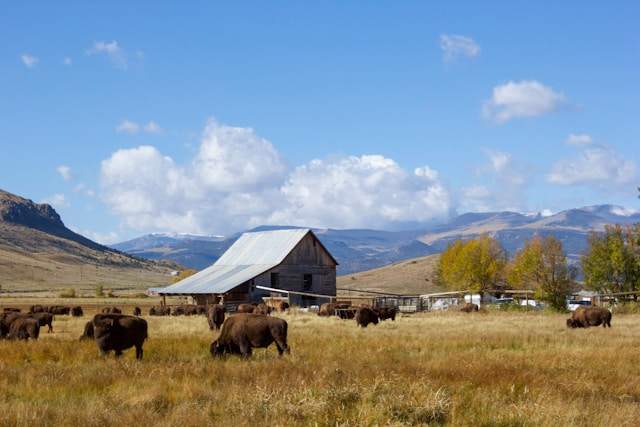A Complete Roadmap on How to Start a Cattle Ranch in 2024
Cattle ranching, believed to have originated as early as 6500 BC in regions of modern-day Turkey, has seen various evolutions. From the domestication of wild aurochs to the expansive ranches of North and South America, this industry has thrived, faltered, and adapted through millennia. Today, it holds a prominent place in global economies, feeding billions and contributing significantly to agricultural outputs. With over 1.5 billion cattle globally and a beef market value exceeding $300 billion, understanding how to effectively establish a cattle ranch can be a lucrative endeavor for those prepared to delve deep.
Yet, beginning a cattle ranch is no straightforward feat. With various factors to consider from choosing the right cattle breed and securing finances to understanding the intricacies of cattle health, it can be a daunting task. This comprehensive guide aims to shepherd aspiring ranchers through this intricate process. As we journey through the multifaceted world of cattle ranching, expect to unearth secrets of the trade, comprehend its historical significance, and gain invaluable insights to navigate potential challenges.
So, whether you’re driven by passion, investment potential, or an undying love for these magnificent creatures, saddle up as we embark on this enlightening journey. By the end, not only will you be well-versed in the art and science of cattle ranching, but you’ll also be equipped with the knowledge and confidence to start your ranching adventure.

Preliminary Considerations Before Starting a Cattle Ranch
Delving into cattle ranching is akin to embarking on a new, uncharted adventure. While the allure of wide open spaces and the companionship of cattle can be inviting, there are numerous factors that potential ranchers must weigh before leaping. Consideration, research, and a touch of introspection are essential to ensuring that your ranching journey begins on a solid footing.
A. Personal Reflection: Are You Truly Prepared?
1. Financial Considerations:
Initial Capital: Starting a ranch involves significant upfront costs. From purchasing land and livestock to setting up infrastructure, the financial demands can be hefty.
Operational Costs: Beyond the initial investment, ranching has monthly and annual expenses. Feed, veterinary care, labor, machinery maintenance, and utilities are recurring costs to anticipate.
Financial Resilience: Given the cyclical nature of agriculture, there will be prosperous times and lean periods. Are you prepared for potential economic downturns or market fluctuations?
2. Time Investment:
Daily Duties: Cattle ranching is not a 9 to 5 job. It requires daily attention—feeding, health checks, maintenance, and more.
Seasonal Demands: Certain seasons, especially calving or marketing periods, may demand more time and effort.
Long-term Commitment: Successful ranching requires years of commitment. The returns, both financial and emotional, often manifest over an extended period.
3. Physical and Mental Demands:
Physically Draining: Handling cattle, repairing fences, and other ranch activities can be strenuous.
Emotional Resilience: Ranching has its ups and downs. From dealing with sick cattle to navigating market challenges, emotional fortitude is crucial.
B. Understanding the Cattle Ranching Business Model:
Income Streams: Determine your primary revenue source—selling meat, dairy products, breeding stock, or a combination.
Market Dynamics: Research local, national, and international beef and dairy markets. Understand price trends, demand cycles, and consumer preferences.
Value Addition: Consider strategies to increase profitability, such as organic farming, direct-to-consumer sales, or agritourism.
C. Market Research and Demand Analysis:
Local Demand: Study your local market’s appetite for beef or dairy products. Is there a niche market, like grass-fed beef or organic dairy, that you can tap into?
Export Opportunities: If your ranch is of significant size, explore the export potential. Understand regulations, certifications, and demand in target countries.
Competitive Analysis: Identify other ranchers in your vicinity. Analyze their strengths, weaknesses, and unique selling propositions.
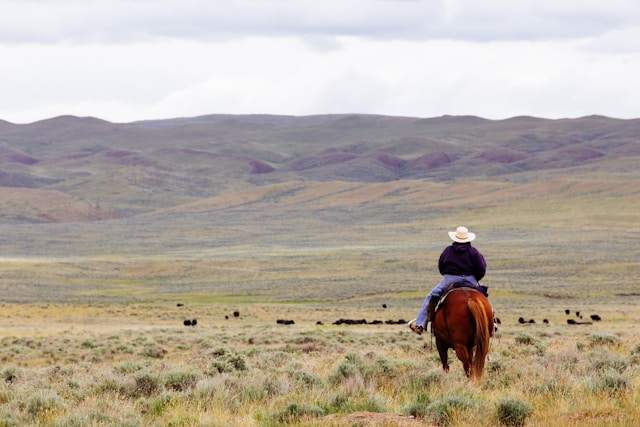
Choosing the Right Location: Laying the Groundwork for Your Cattle Ranching Success
The adage “location, location, location” doesn’t just apply to real estate. In the world of cattle ranching, selecting the right location can make the difference between thriving herds and underperforming livestock. The physical environment plays a pivotal role in determining the health, growth, and productivity of cattle. As you survey potential locations, consider the following critical factors:
A. Climatic Factors and Their Influence on Cattle:
Temperature Ranges: Cattle thrive in moderate temperatures. Extreme cold or heat can stress livestock, affecting their health and growth.
Rainfall Patterns: Adequate rainfall is essential for grass growth. However, excessive rain can lead to muddy conditions and potential diseases.
Seasonal Variations: Consider temperature swings between seasons. Some cattle breeds handle cold better, while others fare well in warmer climates.
B. Soil and Grass Types:
Soil Quality: Rich, loamy soil supports lush pastures. Test the soil to determine its nutritional content and pH levels.
Native Grasses: Research the types of native grasses in the region. Some grasses, like Bermuda or Fescue, offer better nutrition than others.
Forage Potential: The quality of forage determines the health and weight gain of cattle. Optimal locations have a mix of grasses to ensure year-round grazing.
C. Water Source and Availability:
Natural Water Sources: Rivers, streams, or ponds can be valuable assets, ensuring a consistent water supply for cattle.
Water Quality: Test water sources for contaminants. Clean, uncontaminated water is crucial for cattle health.
Water Infrastructure: In areas with limited natural water, consider the feasibility of setting up wells, tanks, or troughs.
D. Proximity to Markets and Processing Facilities:
Accessibility: Your ranch should be easily accessible to major roads or highways for transporting cattle or products.
Nearby Processing Facilities: Having slaughterhouses, dairy processing units, or breeding centers nearby reduces transport costs and stress on cattle.
Local Market Dynamics: Being close to urban centers or market hubs can offer better prices and demand for your products.
E. Zoning and Land Use Regulations:
Agricultural Zoning: Ensure the land is zoned for agricultural use, specifically cattle ranching.
Environmental Regulations: Be aware of any environmental protections or restrictions in the area.
Neighboring Land Use: Scout adjacent properties. Industrial or polluting neighbors can affect your ranch’s air and water quality.
Financial Planning: Steering Your Cattle Ranch to Profitability

Embarking on a cattle ranching journey is as much an economic endeavor as it is a pastoral dream. Crafting a meticulous financial plan is paramount to ensuring sustainability and profitability. Like the robust latticework of a fence, a well-structured financial plan provides the support and direction needed to navigate the complex terrain of cattle ranching economics.
A. Initial Investment Costs:
1. Land Acquisition:
Understand the price per acre in your chosen location. Factor in size, water availability, and proximity to markets.
Consider leasing as an option, especially for newcomers to ranching. It reduces initial outlay and offers flexibility.
2. Livestock Purchase:
Determine the number and type of cattle you intend to start with. Costs vary by breed, age, and purpose (meat, dairy, breeding).
Consider auctions, direct purchases from other ranchers, or breeding programs.
3. Infrastructure Set Up:
Fencing: Robust fences are essential for cattle containment and predator protection.
Housing: Barns, sheds, or shelters protect cattle from extreme weather.
Water Systems: Install troughs, pumps, or wells if natural water sources are insufficient.
Equipment: Tractors, hay balers, and other machinery will incur initial costs.
4. Licensing and Compliance:
Acquire necessary permits, such as water rights, building permits, or environmental clearances.
Registration fees for cattle branding or trademarks.
B. Operating Expenses:
1. Feeding and Nutrition:
Costs of hay, grains, and mineral supplements.
Potential savings from rotational grazing or integrating crop farming.
2. Health and Veterinary Care:
Regular health checkups, vaccinations, and emergency care.
Insurance: Consider livestock insurance to mitigate risks from disease outbreaks or natural disasters.
3. Labor and Management:
Salaries for hired help, if you can’t manage the ranch alone.
Training programs or courses to enhance skills and knowledge.
4. Maintenance:
Repairs for equipment, fences, and structures.
Upgrades or replacements as the ranch grows.
C. Revenue Streams and Projections:
1. Sales of Livestock:
Determine the expected revenue from selling meat, dairy products, or breeding stock.
Analyze market prices and project future trends.
2. Value Added Products:
Cheese, yogurt, or leather goods can diversify income.
Calculate potential earnings from agritourism or farm-to-table events.
3. Government Grants and Subsidies:
Explore federal or state incentives for sustainable farming, land conservation, or rural development.
Stay updated with changing agricultural policies and subsidies.
D. Return on Investment (ROI) and Break-Even Analysis:
Calculate the expected time frame to recover initial investments.
Adjust strategies based on projected revenues and expenses.
Choosing the Right Cattle Breed: Tailoring Your Herd to Your Ranch’s Goals
In the vast mosaic of cattle ranching, the breed of cattle you choose is the defining color. It influences everything from ranch operations to profitability. Just as one wouldn’t plant an orchid in the desert, selecting a cattle breed that’s mismatched to your ranch’s location, objectives, and market can spell disaster. This section offers insights to help you make an informed decision, ensuring that the cattle breed you choose harmonizes with your ranch’s environment and goals.

A. Understand Your Ranch’s Purpose:
1. Beef Production:
For meat-centric operations, breeds with good growth rates, carcass yield, and meat quality are ideal.
Popular breeds: Angus, Hereford, Charolais, Limousin.
2. Dairy Production:
If milk is your focus, breeds with high milk yield and quality are preferable.
Renowned breeds: Holstein, Jersey, Guernsey, Ayrshire.
3. Dual Purpose (Beef & Dairy):
Some ranchers seek breeds that offer both meat and milk benefits.
Notable breeds: Shorthorn, Brown Swiss, Simmental.
4. Breeding and Stocker Operations:
Breeds with good maternal traits, fertility, and calf vitality are sought after.
Breeds to consider: Brahman, Brangus, Gelbvieh.
B. Assess the Environmental Compatibility:
1. Climatic Adaptation:
Some breeds thrive in cold climates (e.g., Highland cattle), while others are suited for hotter regions (e.g., Brahman).
Hair coat, body size, and metabolic rates play roles in climate adaptability.
2. Grazing Preferences:
Breeds like Texas Longhorn are known to graze on less nutritious forage, while others, like Angus, prefer richer pastures.
3. Disease and Pest Resistance:
Certain breeds, such as the Brahman, have developed resistance to pests and some tropical diseases.
C. Evaluate Market Demand and Preferences:
1. Consumer Tastes:
Some markets favor specific meat qualities, like marbling in Angus beef.
Organic or grass-fed beef might have niche markets, influencing breed choice.
2. Dairy Product Varieties:
Breeds like Jersey produce milk with high butterfat, ideal for cheesemaking.
Holsteins, on the other hand, yield large volumes of milk suitable for fluid consumption.
3. Export Potential:
Research international demand for specific breeds. Some countries might pay premiums for particular genetics.
D. Consider Growth Rates and Feed Efficiency:
1. Time to Market:
Faster-growing breeds mean quicker turnovers and potentially higher profits.
Breeds like Charolais or Limousin are known for their rapid growth.
2. Feed Conversion Ratio (FCR):
Efficiency in converting feed to meat or milk affects profitability. Low FCR is desirable.
Angus and Hereford, for example, have commendable FCRs in beef production.
E. Factor in Maintenance and Handling:
1. Temperament:
Docile breeds (e.g., Hereford) are easier to manage, especially for new ranchers.
Aggressive or skittish cattle require more experience and care.
2. Special Care Requirements:
Some breeds, like the Highland cattle, might have unique grooming or sheltering needs.
Ranch Infrastructure and Equipment: Building the Backbone of Your Cattle Ranching Enterprise

When you peel back the picturesque scenes of grazing cattle against the backdrop of rolling hills, you’ll find the intricate web of infrastructure and equipment that keeps a cattle ranch running smoothly. Much like the skeletal system supports our body, a ranch’s infrastructure and equipment provide the necessary framework and tools for efficient operations, safety, and productivity. Here’s a deep dive into the essentials you’ll need and the factors to consider.
A. Infrastructure Essentials:
1. Fencing and Containment:
Types: Barbed wire, electric, post and rail, and high tensile wire fencing.
Purpose: Designate grazing areas, protect from predators, and manage herd movement.
Maintenance: Regular checks for breaches, wear, and tension adjustments.
2. Water Supply Systems:
Natural Sources: Ponds, streams, and rivers.
Artificial Systems: Wells, water tanks, troughs, and automated waterers.
Quality: Periodic testing for contaminants and ensuring accessibility.
3. Shelter and Housing:
Barns: Protection against extreme weather, storage, and calving.
Sheds and Leantos: Offer shade and rain protection in pastures.
Windbreaks: Trees or constructed barriers that reduce wind impact.
4. Handling and Holding Facilities:
Corrals: Temporary containment during health checks or transportation.
Chutes: Safe handling of cattle for medical treatments or branding.
Loading Ramps: Efficient loading and unloading of cattle for transport.
B. Essential Equipment:
1. Machinery:
Tractors: Multipurpose; used for feed distribution, mowing, or pulling equipment.
Hay Balers: For creating bales from cut grass or hay.
Feed Mixers: To ensure a consistent diet mixture for cattle.
2. Vehicles:
Trucks: For transporting cattle, feed, or equipment.
ATVs/UTVs: Quick movement around the ranch; herd checks, and fence inspections.
3. Tools and Miscellaneous:
Branding Irons: For marking cattle for identification.
Ear Tags and Applicators: Alternative or additional identification method.
Medical Kits: Containing essential veterinary tools, medicines, and vaccines.
C. Digital and Technological Solutions:
1. Livestock Management Software:
Efficient tracking of cattle health, breeding, and sales data.
Integration capabilities with financial software.
2. GPS and Drones:
Mapping and monitoring large expanses of land.
Aerial checks on cattle health and movement.
3. Automated Feeders and Milking Machines:
Reduce labor and ensure consistency in feeding and milking.
D. Considerations When Investing in Infrastructure and Equipment:
1. Scalability: Ensure the infrastructure can accommodate future growth.
2. Durability: Invest in quality to reduce frequent replacements or repairs.
3. Safety: Ensure safe operations to protect both the cattle and the handlers.
4. Budgeting: Prioritize essential items, consider leasing, or look for secondhand equipment in good condition.
Cattle Health and Nutrition: Ensuring the Wellbeing and Productivity of Your Livestock

In the heart of every successful cattle ranch beats the pulse of healthy nourished livestock. Cattle health and nutrition aren’t just obligations; they’re investments that yield dividends in the form of productivity, longevity, and quality. Navigating the intricate dance of disease prevention, nutrient management, and timely interventions can be daunting. Let’s break it down to empower you with the knowledge you need.
A. Understanding Cattle Nutrition:
1. Essential Nutrients:
Proteins: Vital for growth, lactation, and repair. Sources include legumes and soybean meal.
Carbohydrates: Provide energy. Found in grains, and forages.
Fats: Dense energy sources. Derived from grains, and supplements.
Vitamins & Minerals: Crucial for various physiological functions. Found in forages, and mineral blocks.
Water: The most vital nutrient. Ensure clean, abundant supply.
2. Balanced Rations:
Create a diet that fulfills all nutrient requirements without excesses or deficiencies.
Use feed analysis to understand nutritional content.
3. Supplements and Additives:
Enhance nutrient content or aid digestion.
Common additives: Probiotics, enzymes, vitamins.
4. Seasonal Nutrition Adjustments:
Modify feed rations based on availability, cattle’s energy needs, and environmental conditions.
B. Disease Prevention and Management:
1. Vaccination Programs:
Protect against common diseases like Bovine Respiratory Disease, Blackleg, and Bovine Viral Diarrhea.
Consult a veterinarian for a region-specific vaccination schedule.
2. Parasite Control:
External parasites: Lice, mites, flies. Use sprays, pour-ons, or dust.
Internal parasites: Worms. Employ deworming protocols.
3. Biosecurity Measures:
Quarantine new animals before introducing them to the herd.
Maintain clean water sources, feeding areas, and shelters.
Monitor visitors and vehicles to prevent disease introduction.
4. Regular Health Checks:
Monthly or quarterly examinations by a veterinarian.
Monitor weight, body condition, and coat health.
C. Stress Management:
1. Proper Handling:
Use low-stress cattle handling techniques to prevent injuries and stress.
Ensure facilities like chutes and corrals are in good condition.
2. Environmental Comfort:
Provide adequate shelter from extreme weather.
Ensure access to shade and cool water during hot periods.
3. Calf Management:
Special attention during birth, ensuring they receive colostrum.
Monitor for calf diseases and ensure timely interventions.
D. Record Keeping:
1. Digital or Manual Logs:
Track vaccination schedules, disease outbreaks, and treatments.
Record nutritional changes and their outcomes.
2. Benefits:
Forecast health and nutritional needs.
Identify patterns or recurrent health issues.
Sustainable Cattle Ranching: Merging Profitability with Environmental and Ethical Responsibility
The cattle ranching of tomorrow isn’t just about profit margins; it’s about weaving the threads of economic viability, environmental stewardship, and societal responsibility into a cohesive tapestry. As global focus shifts towards sustainable practices, ranchers have a golden opportunity to position themselves at the vanguard of this movement. Here’s a comprehensive guide on how to make sustainable cattle ranching a reality.
A. Understanding the Importance of Sustainability:
1. Environmental Responsibility:
Addressing concerns over deforestation, water pollution, and greenhouse gas emissions.
Preservation of ecosystems and biodiversity.
2. Economic Viability:
Sustainable practices can lead to cost savings in the long run.
Meeting consumer demand for sustainably raised beef.
3. Social and Ethical Concerns:
The welfare of the cattle.
Supporting local communities and promoting fair work conditions.
B. Implementing Grass-fed and Rotational Grazing:
1. Grass-fed Livestock:
Healthier cattle due to natural diet.
Reduced reliance on feed crops reduces carbon footprint.
2. Rotational Grazing:
Moving cattle between pastures to prevent overgrazing.
Promotes grass regrowth and soil health.
C. Water Management and Conservation:
1. Efficient Watering Systems:
Implementing drip systems and automatic waterers to reduce waste.
Regular maintenance to prevent leaks.
2. Watershed Protection:
Preventing runoff from contaminating local water sources.
Establishing buffer zones around water bodies.
D. Soil Health and Carbon Sequestration:
1. Soil Testing:
Regularly test soil for nutrient levels and adjust practices accordingly.
2. Cover Crops:
Planting crops that protect and enrich the soil during offseasons.
3. Carbon Farming:
Practices that capture and store carbon in soil, reducing greenhouse emissions.
E. Integrating Renewable Energy:
1. Solar and Wind Power:
Installing solar panels or wind turbines to power ranch operations.
Reducing reliance on nonrenewable energy sources.
2. Biomass and Biogas:
Using cattle waste to produce energy.
Turning a waste product into a valuable resource.
F. Waste Management and Recycling:
1. Manure Management:
Using composting or biodigesters to turn manure into valuable resources.
Preventing manure runoff which can contaminate water sources.
2. Recycling Ranch Waste:
Repurposing or recycling old equipment and materials.
Reducing landfill contributions and wastage.
G. Engaging with the Community and Educating Consumers:
1. Open Ranch Days:
Inviting the public to learn about sustainable cattle ranching practices.
2. Labeling and Marketing:
Clearly labeling beef products as sustainably raised.
Educating consumers on the benefits of sustainable beef.
Cattle Breeding and Population Management: Strategically Nurturing Your Herd’s Future
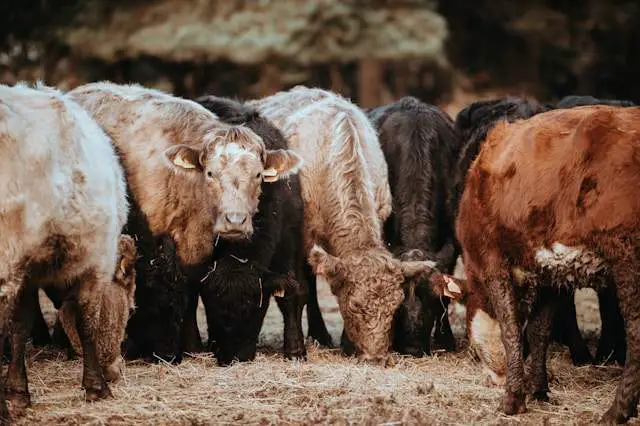
Your cattle herd isn’t just a snapshot of today’s business; it’s a projection of tomorrow’s potential. Ensuring the right genes carry forward, managing herd population effectively, and synchronizing reproductive cycles can spell the difference between a mediocre ranching operation and a booming one. Here’s an in-depth exploration of cattle breeding and population management strategies.
A. Understanding the Goals of Breeding:
1. Genetic Improvement:
Aiming for traits like better meat quality, disease resistance, and higher reproductive rates.
Using pedigree analysis to select breeding pairs.
2. Herd Expansion or Maintenance:
Growing your herd size or maintaining a stable population.
3. Economic Viability:
Breeding strategies that optimize returns on investment.
B. Selection of Breeding Stock:
1. Performance Records:
Evaluating potential breeders based on their growth rates, health history, and offspring performance.
2. Physical Examination:
Evaluating animals for desirable physical traits and ensuring the absence of genetic defects.
3. Genomic Testing:
DNA testing to predict breeding value and trace lineage.
C. Artificial Insemination (AI) and Embryo Transfer:
1. Benefits of AI:
Access to superior genetics without needing to maintain elite bulls onsite.
Greater control over breeding timing and selection.
2. Embryo Transfer:
Amplifying the genetic impact of elite cows by producing multiple offspring.
Combining with AI to maximize genetic gains.
D. Synchronization and Breeding Seasons:
1. Estrous Synchronization:
Using hormonal treatments to align the reproductive cycles of multiple females.
Facilitating planned breeding and calving periods.
2. Breeding Seasons:
Choosing specific times of the year to breed, optimizing for favorable environmental conditions during calving.
E. Population Control and Culling:
1. Objective Culling Criteria:
Removing animals based on factors like age, health, performance, or temperament.
2. Benefits:
Improving herd genetics and overall health.
Optimizing resource allocation.
F. Record Keeping and Analysis:
1. Breeding Records:
Logging details of each breeding event, parentage, and outcomes.
2. Performance Metrics:
Tracking growth rates, health metrics, and reproductive success.
3. Using Data:
Analyzing records to refine breeding strategies and make informed decisions.
Marketing and Selling Your Cattle Products: Transforming Hard Work into Tangible Returns

Once you’ve poured sweat, dedication, and resources into your cattle ranch, the ultimate challenge lies in getting your products into consumers’ hands—and ensuring they come back for more. Successful marketing and selling require a nuanced blend of understanding market dynamics, branding, and relationship building. Here’s your complete guide to navigating the vast avenues of cattle product marketing and sales.
A. Understanding the Market Landscape:
1. Consumer Trends:
Monitoring shifts in consumer preferences such as organic, grass-fed, and antibiotic-free beef.
Keeping abreast of sustainable and ethical livestock practices in demand.
2. Competitor Analysis:
Researching what similar ranches are offering.
Identifying gaps in the market or unique selling points.
3. Price Point Setting:
Analyzing costs of production and market rates.
Balancing profitability with competitive pricing.
B. Branding and Identity:
1. Unique Selling Proposition (USP):
Defining what sets your cattle products apart.
2. Logo and Visual Identity:
Designing memorable logos and branding materials.
Ensuring consistency across all platforms.
3. Storytelling:
Crafting a compelling narrative about your ranch’s history, values, and practices.
C. Product Diversification:
1. Whole Animal Utilization:
Beyond prime cuts: marketing offals, bones, and hides.
Promoting the idea of nose-to-tail consumption.
2. Value Added Products:
Creating products like jerky, sausages, or bone broth.
Offering packages or subscription boxes for regular customers.
D. Selling Channels:
1. Direct to Consumer:
Onsite farm shops.
Online sales via an e-commerce website.
2. Wholesale:
Selling to restaurants, butchers, and grocery stores.
3. Farmers’ Markets:
Engaging directly with consumers and building brand loyalty.
4. Agricultural Fairs and Exhibitions:
Showcasing products and networking with industry stakeholders.
E. Digital Marketing and Social Media:
1. Website Creation:
Building an informative and user-friendly website with e-commerce capabilities.
2. Social Media Engagement:
Regular posts, engaging stories, and behind-the-scenes glimpses on platforms like Instagram, Facebook, and Twitter.
Leveraging influencer partnerships.
3. Email Marketing:
Sending newsletters, offers, and updates to a subscriber list.
4. Search Engine Optimization (SEO):
Optimizing website content for search engines to increase organic traffic.
F. Building Relationships and Trust:
1. Customer Feedback:
Actively seeking reviews and testimonials.
Addressing concerns promptly.
2. Transparency and Education:
Hosting farm visits or virtual tours.
Educating consumers on cattle raising practices.
3. Collaborations:
Partnering with chefs, food bloggers, or other businesses for promotions.
Overcoming Challenges in Cattle Ranching: Strategies to Triumph in a Dynamic Industry

The world of cattle ranching is not without its share of hurdles. From unpredictable weather patterns to evolving market demands, ranchers face a plethora of challenges that require resilience, adaptability, and strategic foresight. This section will delve into some of the predominant challenges in the industry and offer actionable solutions to navigate them successfully.
A. Environmental and Climatic Challenges:
1. Droughts and Water Scarcity:
Implementing water-saving measures like rainwater harvesting.
Adopting drought-resistant pasture varieties.
2. Extreme Weather Events:
Building weather-resistant infrastructure.
Ensuring emergency plans and insurance coverages are in place.
3. Pest and Predator Management:
Employing natural deterrents and integrated pest management.
Securing cattle areas to protect from predators.
B. Economic and Market Fluctuations:
1. Price Volatility:
Hedging against price fluctuations using futures contracts.
Diversifying revenue streams through value-added products and agritourism.
2. High Input Costs:
Regularly reviewing and negotiating supplier contracts.
Exploring bulk purchasing or cooperative buying options.
3. Changing Consumer Preferences:
Staying updated with market trends and adjusting offerings accordingly.
Investing in market research and consumer feedback.
C. Health and Disease Management:
1. Disease Outbreaks:
Establishing strict biosecurity measures.
Regular health checkups and vaccination schedules for cattle.
2. Nutritional Deficiencies:
Soil and forage testing to ensure nutrient-rich feed.
Supplementing cattle diet as necessary.
D. Regulatory and Compliance Issues:
1. Ever Changing Regulations:
Regularly reviewing local, state, and federal livestock regulations.
Attending industry workshops and seminars for updates.
2. Certifications and Audits:
Ensuring all practices align with certification standards, if applicable.
Preparing comprehensive records for audit purposes.
E. Labor and Workforce Challenges:
1. Skilled Labor Shortage:
Offering competitive wages and benefits.
Investing in training and skill development programs.
2. Safety Concerns:
Implementing stringent safety protocols.
Regularly reviewing and updating safety equipment.
F. Technological Adaptations:
1. Keeping Up with Tech Trends:
Investing in modern farm management software.
Utilizing technologies like drones for surveillance and herd monitoring.
2. Resistance to Change:
Encouraging a culture of continuous learning within the ranch team.
Hosting tech workshops and demonstrations.
Embracing Modern Technology in Cattle Ranching: The Digital Transformation of a Timeless Trade
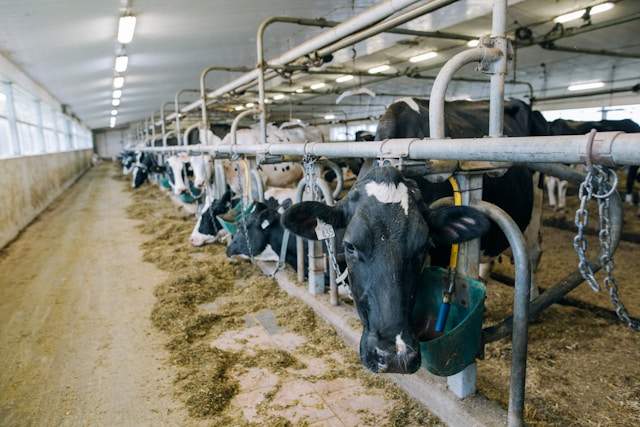
Gone are the days when cattle ranching was solely about the tactile connection between man, beast, and land. Today, digital footprints walk alongside actual hoof prints, and modern technology intertwines seamlessly with age-old ranching traditions. In this section, we delve deep into how cattle ranching is being revolutionized by technological advancements and how you can integrate them into your ranch operations for maximized efficiency and profitability.
A. Digital Record Keeping and Management Systems:
1. Farm Management Software:
Centralizing data about livestock, breeding records, health stats, and financial metrics.
Enabling swift decision-making and projections.
2. Cloud-Based Systems:
Offering remote access to ranch data from any device.
Ensuring data backup and protection.
B. Precision Agriculture and Monitoring:
1. Drones:
Aerial surveys to monitor herd location, health, and pasture conditions.
Efficiently assessing large expanses of land.
2. Soil and Water Sensors:
Monitoring moisture levels and soil health in real-time.
Guiding irrigation and fertilization decisions.
3. GPS and GIS Technology:
Mapping pasture rotations, water sources, and infrastructure.
Tracking cattle movements and grazing patterns.
C. Livestock Wearables and Tracking:
1. RFID and Ear Tags:
Instantly identifying cattle and accessing their history.
Streamlining inventory and health checks.
2. Smart Collars and Implants:
Monitoring vital signs, activity levels, and behavioral changes.
Predicting illnesses or calving events.
D. Artificial Intelligence and Data Analytics:
1. Predictive Analytics:
Analyzing data to forecast disease outbreaks or market fluctuations.
Enhancing herd management and financial planning.
2. Automated Image Recognition:
Identifying potential issues like lameness or weight loss through cameras.
Offering nonintrusive health assessments.
E. Sustainable Tech Innovations:
1. Solar Powered Infrastructure:
Using renewable energy for fences, barns, and water systems.
Reducing the ranch’s carbon footprint.
2. Biogas and Manure Management:
Converting cattle waste into usable energy.
Sustainable and cost-effective waste management.
F. Virtual Engagement and Marketing:
1. Virtual Farm Tours:
Showcasing your ranch operations to potential customers or investors.
Enhancing transparency and trust.
2. E-Commerce Platforms:
Facilitating direct-to-consumer sales through a digital storefront.
Expanding market reach and customer engagement.
A Day in the Life of a Cattle Rancher: From Dawn to Dusk on the Fields
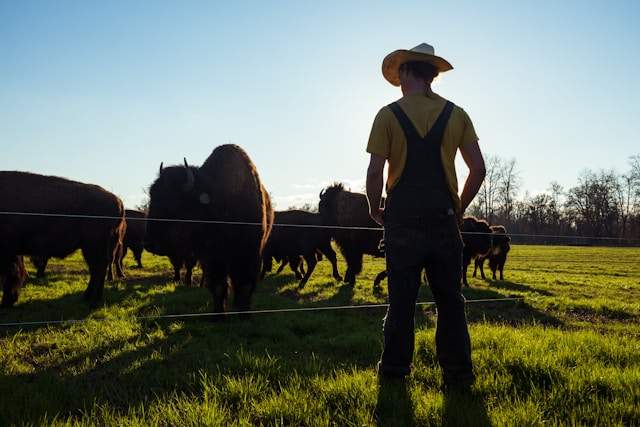
Cattle ranching is more than just a profession—it’s a way of life, marked by early mornings, physical labor, and deep connections with the land and livestock. But what does a typical day look like for a cattle rancher? Let’s walk through a day, from sunrise to sunset, capturing the essence, challenges, and rewards of this enduring profession.
A. The Early Bird Gets the Worm:
1. Sunrise Rituals:
Waking up before dawn to the sounds of nature.
Sipping that essential cup of coffee while reviewing the day’s to-do list.
2. Morning Feed:
Checking and replenishing feed and water troughs.
Observing the cattle’s behavior to ensure they are active and healthy.
B. Herd Health and Monitoring:
1. Routine Checkups:
Walking or riding through pastures to keep an eye on the cattle.
Administering vaccinations or treatments as scheduled.
2. Newborn Calves:
Assisting with births if necessary.
Ensuring that calves are nursing and bonding with their mothers.
C. Maintenance and Repairs:
1. Fence Patrol:
Inspecting and mending any broken fences.
Ensuring security against predators and stray cattle.
2. Equipment Checks:
Servicing tractors, feeders, and other machinery.
Repairing any malfunctioning equipment.
D. Pasture and Land Management:
1. Rotational Grazing:
Moving cattle between pastures to ensure sustainable grazing.
Observing the health of the pastures and planning for reseeding or irrigation.
2. Water Management:
Checking water sources like ponds, streams, or troughs.
Cleaning and maintaining water systems.
E. Afternoon Activities:
1. Record Keeping:
Updating digital or manual logs about cattle health, births, sales, or expenses.
Analyzing data for trends or areas of concern.
2. Networking and Communications:
Touching base with suppliers, veterinarians, or potential buyers.
Researching market trends and consumer preferences.
F. Winding Down the Day:
1. Evening Feed:
Ensuring cattle have ample feed as the day ends.
Checking water supplies for the night.
2. Reflection and Planning:
Take a moment to appreciate the land and livestock.
Preparing for the next day’s activities or long-term projects.

Frequently Asked Questions (FAQs) About Starting a Cattle Ranch
Embarking on the journey of starting a cattle ranch is filled with questions. Here, we aim to provide clear, concise answers to some of the most frequently asked questions, combining foundational knowledge with insights into the nuances of the cattle ranching industry.
1. How much land do I need to start a cattle ranch?
The amount of land required for a cattle ranch varies significantly depending on several factors, including the type of cattle, the nature of the ranching (grass-fed vs. feedlot), and geographical location. As a general guideline, you might need anywhere from 1.5 to 2.5 acres per cow-calf pair in areas with lush pasture, but this can increase substantially in drier climates.
2. What are the initial costs involved in starting a cattle ranch?
Initial costs can range widely but typically include land acquisition, livestock purchase, fencing, barn and shelter construction, water system installation, and basic equipment and machinery. Depending on the scale and location, these costs can start from a few tens of thousands to several million dollars.
3. How do I choose the right cattle breed for my ranch?
Choosing the right breed involves considering your ranching goals (meat, dairy, or dual-purpose), climate adaptability of the breed, market demand, and the breed’s temperament and maintenance needs. Research and consultations with local agricultural extensions or experienced ranchers can provide valuable insights.
4. What are the key components of cattle health and nutrition?
Cattle health and nutrition revolve around providing a balanced diet rich in essential nutrients (proteins, carbohydrates, fats, vitamins, minerals), clean water, regular vaccinations and health check-ups, effective parasite control, and stress management practices.
5. How can I make my cattle ranch more sustainable?
Sustainability can be achieved through practices like rotational grazing, efficient water use, soil health management, integration of renewable energy sources, and adoption of technologies for precision agriculture. Prioritizing animal welfare and engaging in community and environmental conservation efforts are also key.
6. What technologies are changing the face of cattle ranching?
Modern cattle ranching is being transformed by farm management software, livestock wearables for health monitoring, drones for land and livestock surveillance, artificial intelligence for data analysis and predictive insights, and online marketing platforms for direct-to-consumer sales.
7. How do I market and sell my cattle products effectively?
Effective marketing involves understanding consumer trends, creating a strong brand identity, diversifying product offerings, and utilizing multiple selling channels including direct-to-consumer, wholesale, farmers’ markets, and online platforms. Digital marketing strategies and storytelling can enhance visibility and engagement.
8. What are the common challenges in cattle ranching, and how can I overcome them?
Common challenges include environmental and climatic issues, economic and market fluctuations, health and disease management, and regulatory compliance. Overcoming these challenges requires adaptive management practices, financial planning, continuous learning, and leveraging community and technological resources.
9. Can cattle ranching be profitable?
Yes, cattle ranching can be profitable, but it requires careful planning, efficient operations management, market analysis, and sometimes, diversification of income sources. Profitability also depends on factors such as scale, location, management practices, and market dynamics.
10. Where can I find more resources and support for starting my cattle ranch?
Prospective ranchers can find resources and support from agricultural extension services, cattle ranching associations, local farming communities, agricultural colleges and universities, online forums, and industry publications. Government agencies may also offer grants, loans, and advisory services for new ranchers.
The Evocative Symphony of Cattle Ranching
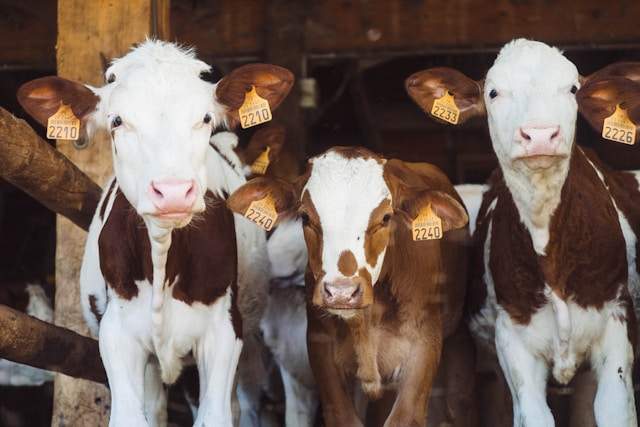
From the rhythmic sound of cattle grazing in sprawling pastures to the reassuring hum of modern machinery at work, cattle ranching is an intricate dance of tradition and innovation, of challenges, met with grit and joys celebrated with gratitude. As we come to the end of this comprehensive guide, let’s reflect on the profound journey of starting and running a cattle ranch.
A Tapestry of Lessons:
Cattle ranching, as we’ve explored, is not merely an occupation but a lifestyle. The pages of this guide have woven a tapestry of lessons—ranging from the importance of location and financial planning to the embrace of modern technology and the value of sustainable practices.
The Power of Adaptation:
One resounding theme that emerges is the power of adaptation. Whether adapting to market fluctuations, unpredictable weather, or evolving consumer demands, the successful cattle rancher remains agile, always willing to learn and innovate.
Beyond the Bottom Line:
While profitability is a vital aspect of cattle ranching, the real rewards often lie beyond the balance sheet. The connections forged—with the land, the cattle, the community, and within oneself—provide an immeasurable sense of purpose and fulfillment.
An Invitation to Dive Deeper:
For those inspired to embark on the journey of cattle ranching, consider this guide not as a culmination, but as a starting point. There are always more stories to hear, technologies to explore, and techniques to perfect. Dive deeper, engage with the community, and let the world of cattle ranching unveil its myriad treasures.
Parting Thought:
In the words of renowned rancher and author, Joel Salatin, “We need to respect both the ecology of the earth and the ecology of the economy.” As future stewards of cattle ranching, let’s strive to create a harmonious balance between nurturing our livestock, preserving our planet, and fostering a sustainable and prosperous business.

